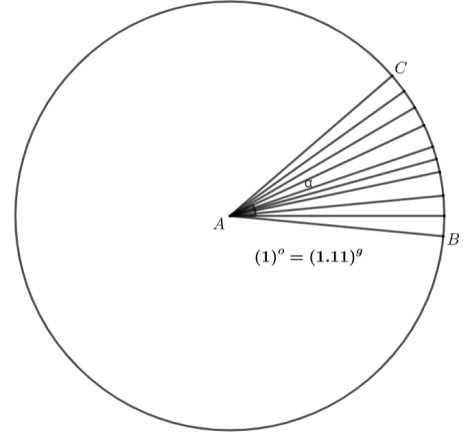Question
Question: One angle of a triangle is \({{\left( \dfrac{2x}{3} \right)}^{g}}\) and another is \({{\left( \dfrac...
One angle of a triangle is (32x)g and another is (23x)∘, whilst the third angle is (75πx)c. Express them all in degrees.
Solution
Hint: We will apply the concept of relationship between grade and radians. This is given by one right angle 90 degrees is equal to 100 grad. This can be numerically written as 90∘=100g. Also, we will use the formula which is given by (π)c=180∘ to solve the question. This can also be written as (1)c=(π180)∘ after dividing the equation by π.
Complete step-by-step answer:
According to the question we get the required diagram of the triangle which is shown below.

Now, we will consider the diagram for understanding the grade, radians and degree.
The grade is represented as the division of the degree into 910 grades. The grade is represented as the division of 10 degrees into 9 grades. It is represented in the figure shown below.

Here, (9)∘ is divided into 10g. The numerical formula is given by 90∘=100g.
Also, the radian is an arc which is formed by two radiuses in a circle joining together at point A. Now, the relation between radians and degree is given by (π)c=180∘. This can also be written as (1)c=(π180)∘ after dividing the equation by π. The diagram is shown below.

Now, we will consider (32x)g and we will convert into degrees by the formula given by 90∘=100g or, (1)g=(109)∘. We can write (32x)g as 32x×(1)g. By substituting (1)g=(109)∘ in 32x×(1)g we get,
32x×(1)g=32x×(109)∘⇒32x×(1)g=(32x×109)∘⇒32x×(1)g=(1x×53)∘⇒32x×(1)g=(53x)∘...(i)
Now we will consider (23x)∘...(ii). Since, it is already in degrees so we will remain it as it is.
Now, we will consider (75πx)c and we will convert the radians into degrees. As we know that (75πx)c can be written as (75πx)c=75πx×(1)c. Now, after this we will use the formula given by (1)c=(π180)∘. Therefore, we have
(75πx)c=75πx×(1)c⇒(75πx)c=75πx×(π180)∘⇒(75πx)c=(75πx×π180)∘⇒(75πx)c=(5x×112)∘⇒(75πx)c=(512x)∘...(iii)
As we know that the sum of the angles of a triangle is equal to 180 degrees. Therefore, we have
(32x)g+(23x)∘+(75πx)c=180∘⇒(53x)∘+(23x)∘+(512x)∘=180∘
Now as we know that the l.c.m. of 5, 2 and 5 is 10. Therefore, we have
⇒(53x+23x+512x)∘=180∘⇒(106x+15x+24x)∘=180∘⇒(1045x)∘=180∘⇒1045x=180⇒x=180×4510⇒x=4×110⇒x=40
Now, we will substitute the value of x in (i) thus we get (53x)∘ as (53(40))∘=(5120)∘ or, 24∘. After this we will substitute the value of x in (ii) therefore, we have
(23x)∘=(23(40))∘⇒(23x)∘=(2120)∘⇒(23x)∘=60∘
And by substituting x = 40 in (iii) we have
(512x)∘=(512(40))∘⇒(512x)∘=(5480)∘⇒(512x)∘=96∘
Hence, the required angles of a triangle are 24∘,60∘,96∘.
Note: Always remember that the sum of all the interior angles of a triangle is equal to 180 degrees. Be aware to use π=180∘ and cancel the value. This will lead to wrong answers. First observe in what power the term is given to us which is going to be converted into degrees. As we can see that one angle is in grade, one in degrees and one is in radian. Then, apply the formula accordingly.
